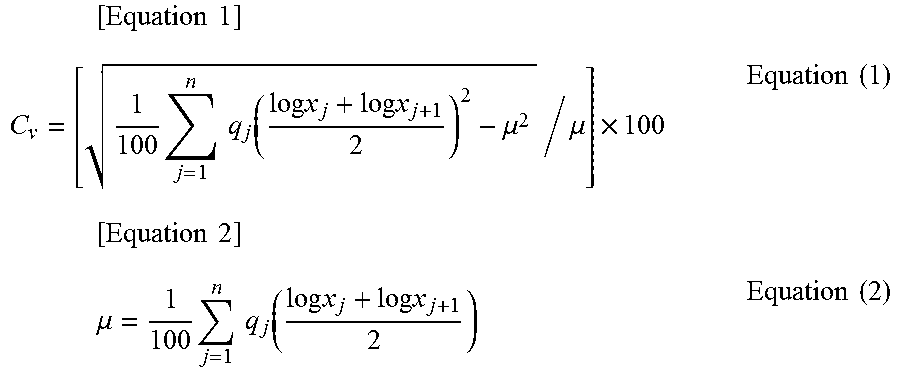Large-diameter heat-expanding microspheres and method for producing same
- Summary
- Abstract
- Description
- Claims
- Application Information
AI Technical Summary
Benefits of technology
Problems solved by technology
Method used
Image
Examples
example 1
Preparation of Aqueous Dispersion Medium Containing Dispersion Stabilizer
[0065]An aqueous dispersion medium containing a dispersion stabilizer was prepared by adding 6 g of colloidal silica serving as a dispersion stabilizer (30 g of a silica dispersion with a solid content of 20 mass %), 0.7 g of a condensation product of diethanolamine and adipic acid serving as an auxiliary stabilizer (acid value: 75 mgKOH / g) (1.4 g of a dispersion with a solid content of 50 mass %), and 0.09 g of sodium nitrite serving as a polymerization aid to 534 g of saltwater (NaCl concentration: 25 mass %). The pH of the aqueous dispersion medium containing a dispersion stabilizer was adjusted to 3.5 by adding 5 mg of hydrochloric acid to the aqueous dispersion medium.
Preparation of Polymerizable Mixture Containing Foaming Agents and Polymerizable Monomers
[0066]On the other hand, an oily mixture was prepared using 100.5 g of acrylonitrile, 46.5 g of methacrylonitrile, and 3.0 g of methyl methacrylate servi...
example 2
[0069]Heat-expandable microspheres were obtained in the same manner as in Example 1 with the exception that the composition of the polymerizable monomers were changed to a composition of 103.5 g of acrylonitrile, 45.0 g of methacrylonitrile, and 1.5 g of methyl methacrylate (mass ratio: acrylonitrile / methacrylonitrile / methyl methacrylate=69 / 30 / 1) and that the composition of the foaming agents were changed to a composition of 1.95 g of isopentane (1.3 parts by mass per 100 parts by mass of the total amount of the polymerizable monomers), 15.15 g of isooctane (10.1 parts by mass per 100 parts by mass of the total amount of the polymerizable monomers), and 10.65 g of isododecane (7.1 parts by mass per 100 parts by mass of the total amount of the polymerizable monomers) to prepare an oily mixture (the total amount of the foaming agents was 18.5 parts by mass per 100 parts by mass of the total amount of the polymerizable monomers). The characteristics of the heat-expandable microspheres ...
example 3
[0070]Heat-expandable microspheres were obtained in the same manner as in Example 1 with the exception that the composition of foaming agents were changed to a composition of 3.0 g of isopentane (2.0 parts by mass per 100 parts by mass of the total amount of the polymerizable monomers), 18.0 g of isooctane (12.0 parts by mass per 100 parts by mass of the total amount of the polymerizable monomers), and 24.0 g of isododecane (16.0 parts by mass per 100 parts by mass of the total amount of the polymerizable monomers) to prepare an oily mixture (the total amount of the foaming agents was 30.0 parts by mass per 100 parts by mass of the total amount of the polymerizable monomers), and that the temperature of free foaming was changed to 160° C. The characteristics of the heat-expandable microspheres and the like are shown in Table 1.
PUM
| Property | Measurement | Unit |
|---|---|---|
| Temperature | aaaaa | aaaaa |
| Fraction | aaaaa | aaaaa |
| Percent by mass | aaaaa | aaaaa |
Abstract
Description
Claims
Application Information
 Login to View More
Login to View More - R&D
- Intellectual Property
- Life Sciences
- Materials
- Tech Scout
- Unparalleled Data Quality
- Higher Quality Content
- 60% Fewer Hallucinations
Browse by: Latest US Patents, China's latest patents, Technical Efficacy Thesaurus, Application Domain, Technology Topic, Popular Technical Reports.
© 2025 PatSnap. All rights reserved.Legal|Privacy policy|Modern Slavery Act Transparency Statement|Sitemap|About US| Contact US: help@patsnap.com

